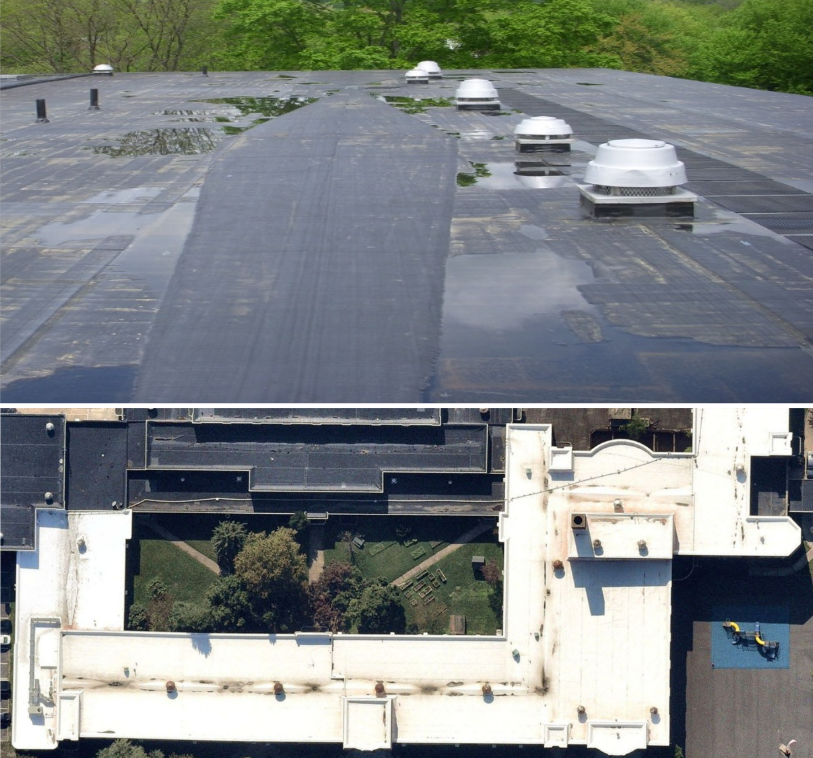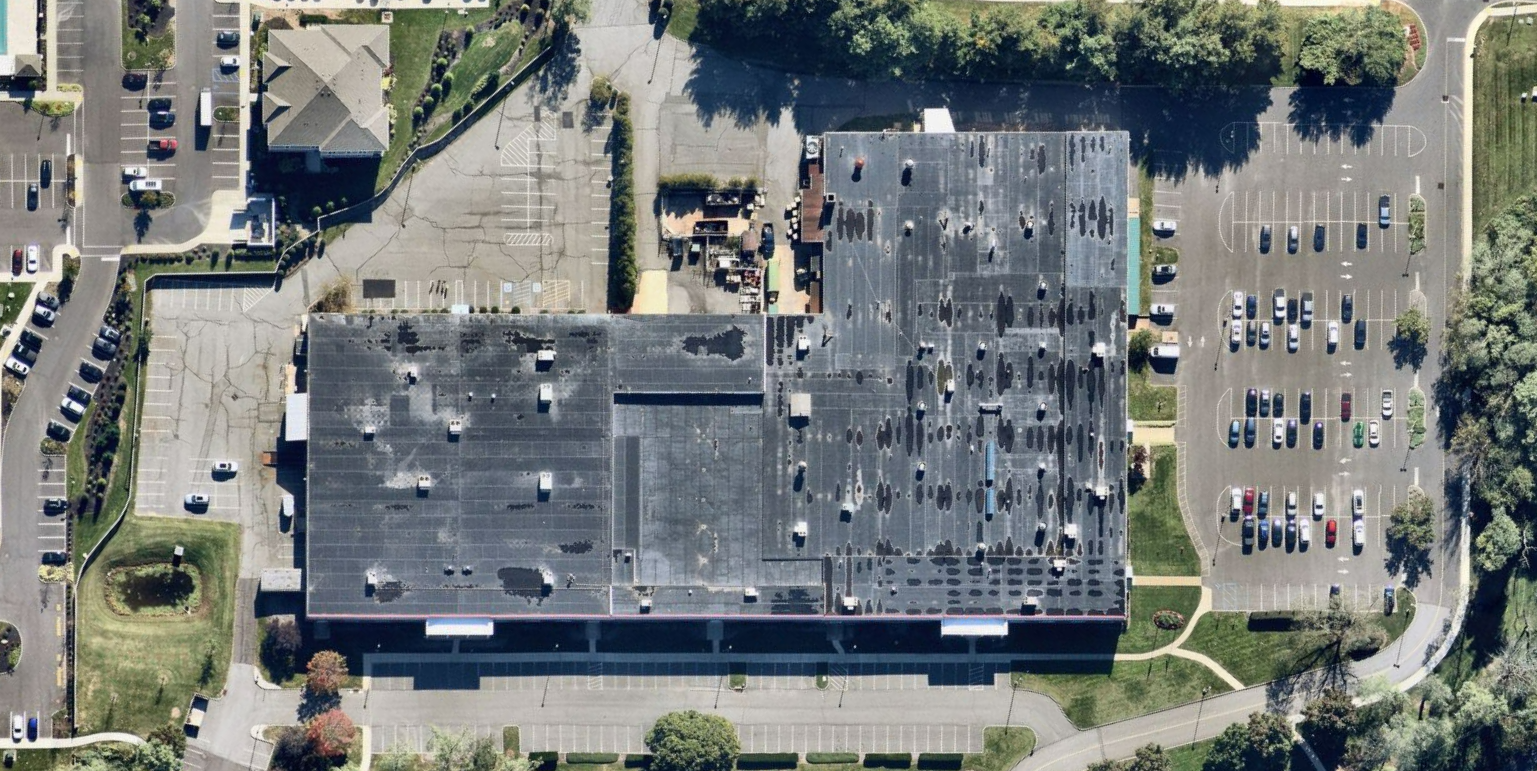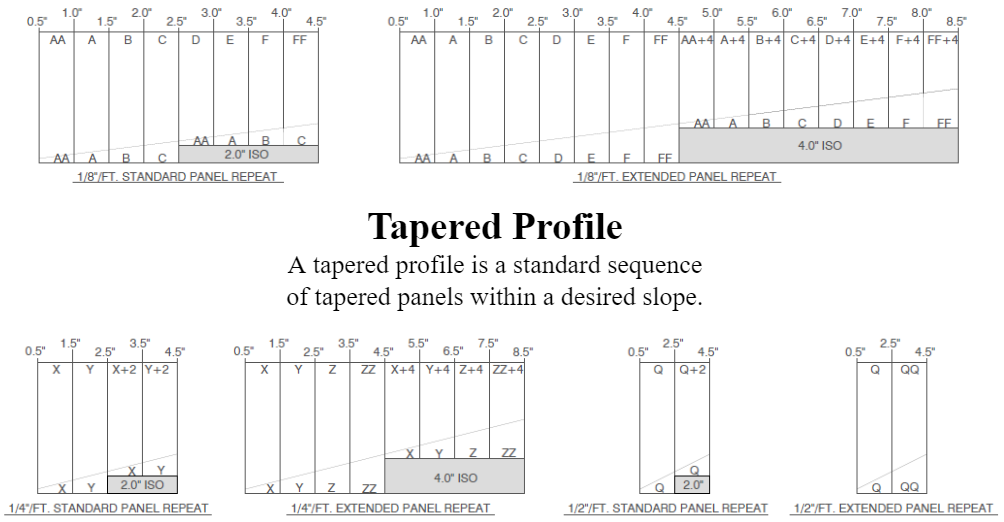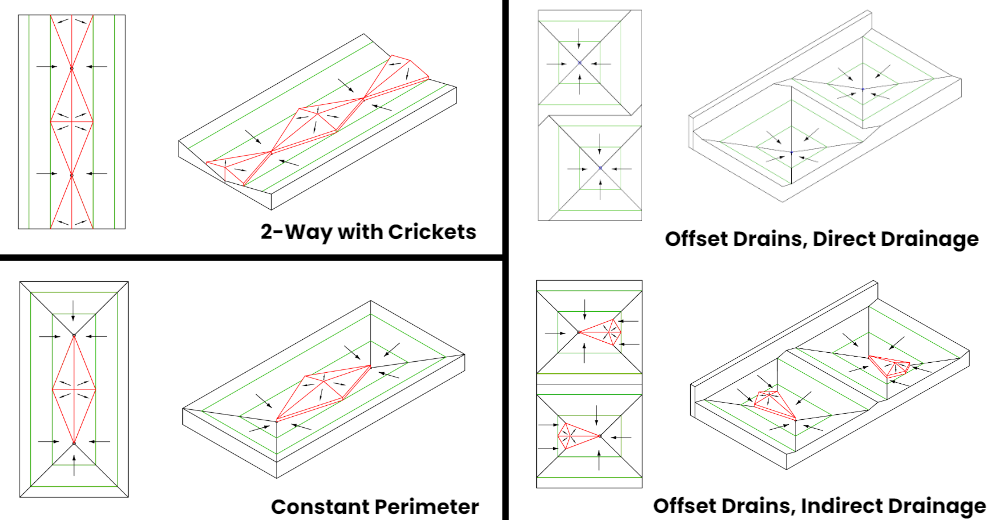As unique as humans are, the same can be said for the built environment we work in. Each building has its own story, shape, function, and there is no one-size-fits-all solution when designing with tapered panels. A possible design for a roof with internal drains is to point the tapered panels in a way to create a single valley between the drains, connecting them. A two-way slope is straightforward to install and preferred by contractors for its minimal cutting waste as more full panels can be utilized and laid out in straight lines. However, this design can allow for water to sit in the valley and against the roof perimeter without being able to evacuate in a timely manner. There is a design element that can be added to increase drainage: crickets. Crickets are built with cut tapered panels and are an overlay to the tapered system. Their purpose is to help divert water to the drain by stretching out the flat valley they cover into separate, smaller, lower-sloping valleys at the cricket’s edges.
While there is direct flow to the drains from the tapered system, there is indirect flow from the crickets. Crickets are necessary to aid in rainwater mitigation but can also introduce issues like standing water at their edges if utilized incorrectly. In the case of offset drains seen in Figure 4, the upper design solution is direct but requires more miter cut ridges and valleys. By stretching out the valleys and lining up the drains, the lower solution simplifies the amount of cutting. Crickets are added because they are needed to help push water around the expanded valley. The perimeter shape of the roof and drain placement dictate the outcome of the tapered design, especially when designing for a constant perimeter height. This is when the tapered system has the same max height around the entire roof perimeter, but this cannot always be achieved if the drains are not centrally located and aligned. It is important to remember the performance expectations when considering a tapered insulation system design. The application method, drainage expectation, and budget are critical when finding the right balance for clients.
The following animation helps to visualize how tapered panels are arranged in a few simple designs to point rainwater towards drains and evacuate water off of a roof, including the aforementioned designs above.
Video courtesy of GAF; credit: Tapered Design Group
Tapered panel designs with animated rainwater simulating water evacuation.
The Necessity of Crickets
Crickets, or saddles, are a necessary design feature and can work efficiently—if they are designed correctly. Crickets, or saddles, are an overlay to a tapered insulation system or to a flat-insulated structurally sloped system by diverting water to the drains.

Figure 4: Diagram of a cricket and common terminology.
Crickets are a design feature that can work efficiently if they are designed correctly. Crickets are assembled from cut tapered panels, so they have their own panel slope to refer to. The unwritten rule is that the cricket panel slope should be twice of the roof field or tapered slope. If the tapered system is 1/4-inch per foot then the crickets would need to be 1/2-inch per foot. Cricket valley slope is the critical aspect that determines how effective a cricket will be. If the cricket design does not create enough of a slope along the outer edges it can introduce standing water. In most cases, the wider the cricket, the greater the cricket valley slope will be, aiding in moving water off of the roof.
The NRCA states that the total cricket width should be between one-quarter and one-third of the overall length, erring on the wider side to ensure proper water diversion. This works for a majority of cricket applications, but it is still possible for crickets to be inefficient if the designer does not consider the cricket valley slope in regards to the tapered or roof field slope. Wider is always better if the space permits. Working with a professional tapered designer ensures that crickets are adequately sized. Panel designers are also the first people who can offer design recommendations and alternatives.
Building owners can protect their investment even if the roof only requires crickets to push water to drains, with the roof field slope built into the deck. Slope can be already designed into the roof structure using sloped wooden trusses or metal beams installed at a specific angle to achieve a desired roof slope. These projects see the most on-site changes decided by the roofing installer at the time of installation, whether their decision is to save on labor or minimize cutting by reducing the size of the crickets. These field reductions are problematic when the provided plan is ignored because planning cannot be done in advance to prevent the potential of standing water due to undersized crickets. Changes to the design such as reducing cricket width should be communicated with the tapered insulation designer to confirm if the reduction in size will still yield an efficient cricket that drains rainwater off of the roof.

Figure 5: Undersized crickets that leave standing water and accumulated dirt because they are inefficient for their application.
To help visualize these cricket issues, an image of a cricket is provided that has been reduced in size so drastically that it does not resemble a cricket nor function as it needs to. The cricket valley slope in this example is close to 0 inches per foot, evident by the standing water seen on the roof. Undersized crickets do not divert water quick enough to the drains and allow dirt to gather, encouraging algae and bacteria growth. While membrane manufacturers may allow for a ponding exclusion in their material warranties because they believe the membrane will stand the test of time, allowing for undersized crickets can prematurely shorten the service life of the membrane and not only cause performance issues, but aesthetic issues as well if lower levels with collected dirt can be seen from above.
Designing for Slope and Designing for Shape
Architects and building design professionals have to consider a plethora of details to put together not only the roofing assembly, but various other components in the scope of work. For the roof to function with a tapered insulation system, the most important factors to consider are the required slope by code or project details, and the placement of the drains and scuppers. These details shape the overall design and will highlight areas of concern where insulation heights can get tall, such as door or window thresholds. Historically, roofs were just meant to shelter its inhabitants from the elements, but now the underutilized potential of roof surfaces is being realized. The sky's the limit for large installations in the world of commercial roofing, such as solar and vegetative roofing, or amenity decks. The impacts on the sustainability goals of a building include: increased energy efficiency, rainwater retention, energy generation, biohabitat restoration, food production, reduced urban heat island effect, and outdoor space.

Figure 6: A project rendering showing multiple levels of roofing.
In most cases, drafting and supplying just the top-level roof plan in the drawing set is not enough. A roof plan may only show that specific level at that specific height and not lower or higher levels that are considered roofs such as entrance canopies, terraces and balconies, and bulkhead roofs such as stairs and elevators. It is common for roof plans to be shown on the floor plan level that they exist on. It is best to submit floor plans for each floor as well as the roof plans for projects with multiple levels.
A rendering is a great way for other roofing professionals to quickly identify where roof areas are. Designers may include slope lines on roof plans as a hint that those areas will need a roofing assembly, but their ability to convey what their performance expectations are may be limited. Details outlining deck type and insulation assembly should be provided for each roof surface to help roofing professionals understand the project parameters. A project manual should also be included to further specify performance and installation directions. This information has a direct influence on not only the tapered design but the insulation assembly as well. To assist building design professionals, the following examples will walk through how a tapered solution is applied to a roof plan.

All images courtesy of GAF; credit: Tapered Design Group
Image of a roof with standing water.
Why is Drainage Necessary?
When someone learns that ‘tapered designer’ is an occupation, their usual reaction is asking “what does that mean?” A simple response is that a tapered designer’s role is to ensure that a roof does not become a swimming pool when it rains. A roof should not become a water feature! Architect Magazine reported that almost half of all building-related issues are due to water intrusion.1 Furthermore, 75 percent of construction defect disputes are related to roof failure.2 This is magnified in commercial roofing where a majority of buildings incorporate low-slope roofs, some completely flat. We are all familiar with the steep slopes seen in residential roofing that use gravity to handle rainwater, but when the roof decks do not provide adequate slope to the drain such as in low-slope or flat roofs, a special consideration needs to be taken to eliminate standing water by adding positive drainage with tapered insulation panels. This visual article will outline tapered design fundamentals to help architects and building designers achieve positive drainage in their low slope applications.

Figure 1: Image of an industrialized area of Secaucus, N.J.
Ensuring your building is watertight at the roof level and preventing water infiltration is only one benefit of a tapered insulation system. Other performance aspects such as R-value and compressive strengths will later be analyzed. Focus on the concentration of commercial roofs in the heavily industrialized area pictured. Whether those are storage or manufacturing facilities, office and retail spaces, even large residential apartment or condo complexes, their roofs cover significant square footage. Given the large footprint of commercial buildings, managing rainwater is the key component of tapered insulation design.
Standing water on a roof is a clear indicator that there isn’t positive drainage present to allow for water to evacuate the roof in a timely manner. The term “positive roof drainage” is defined in the 2018 International Building Code as “the drainage condition in which consideration has been made for all loading deflection of the roof deck, and additional slope has been provided to ensure drainage of the roof within 48 hours of precipitation.”3 Even though a flat roof could be considered watertight, the potential for problems still may arise. Standing water promotes vegetation growth, and issues such as seam separation from material degradation or freezing damage increase the potential for that water to make its way into the system. A dangerous problem slow moving or ponding water also creates is added weight to the structure. To put it into perspective, one gallon of water weighs just over 8 pounds. If an inch of standing water is present on a roof, it can add thousands of pounds to the building structure and lead to life-safety concerns due to a roof collapse. Tapered insulation panels help evacuate rainwater by pointing it to drains or scuppers and creating positive drainage.
Tapered insulation systems work the same way as steep-slope shingle roofs- just with a much more gradual slope. Instead of inches per foot, the 2018 IBC requires a minimum slope of 1/4-inch per foot for membrane roof systems, and a minimum slope of 1/8-inch per foot for coal tar pitch roofs. New construction must comply with the minimum slope requirements in IBC Section 1507, which outlines specifications for roof assemblies and rooftop structures. Recovers or roof replacements of existing low slope roofs are exempt from the minimum 1/4-inch per foot slope requirement. Understanding these constraints can allow for a more fine-tuned tapered design that achieves project-specific goals.
Tapered Polyisocyanurate
Polyisocyanurate, referred to as polyiso in short, makes up over eighty percent of the commercial roofing market share. It has the highest thermal efficiency in terms of R-value at 5.7 per inch. R-value is the capacity for an insulating material to resist heat flow. The higher the R-value, the greater the insulating value. Expanded polystyrene, or EPS, is a popular alternative, but since it has less thermal efficiency, you have to use more of it to compensate for energy losses. Polyiso has very low ozone depleting potential as well as very low global warming potential. It can use recycled content in the facer. It is free of hydrofluorocarbon, an ozone depleting chemical, and can even contribute towards Leadership in Energy and Environmental Design, or LEED, a global green building rating. With 20 polyiso manufacturing facilities nationwide, material is readily available and allows for a great variation of design flexibility to meet job requirements. There are different panel facers available such as felt or recycled and coated glass. Felt or recycled content facers are standard but do not have the reinforced strength of coated glass. Coated glass facers are made by mixing fiberglass in a slurry and gives polyiso panels added strength against job-site damage and greater resistance to moisture intrusion, all leading to longer assembly life cycles. There are also different formulations like non-halogenated which eliminate halogenated flame retardants in its chemical makeup. Halogenated flame retardants are on the Red List, a list of worst-in class chemicals and materials identified for their risk to the environment.4 This allows the range of non-halogenated polyisocyanurate panels to be categorized as Red List free and meet even greater ecological initiatives. Polyiso is a versatile material successfully used to meet code approval requirements for FM (Factory Mutual) and UL (Underwriter’s Laboratory), among others.
Tapered polyisocyanurate is available in thicknesses from 1/2 to 4.5 inches, however, smoothing the transition to a height of 0 inches cannot be reached with these panels. There are other products on the market like tapered edge strips that can be utilized to aid the transition to the roof deck. Tapered panel systems are available in slopes from 1/16-inch per foot to 1/2-inch per foot. The standard panel size is 4 feet by 4 feet, and a panel size of 4 feet by 8 feet is available if specified (and may require longer lead times to fulfill). There are also different compressive strengths that can be catered for specific applications such as amenity spaces with paver systems. Tapered polyiso is compatible with all roofing systems including built-up roofing, ballasted, and modified bitumen. It can be used with coverboards and also can be directly installed to the deck since it is the only foam plastic to pass UL 1256, a fire abatement standard for fire testing of a roof deck construction and FM 4450, qualifying tapered polyiso as a Class I assembly component when part of an insulated steel deck.5 This is because it has “low fire spread below the deck, adequate simulated wind uplift resistance, minimum heat damage potential and adequate strength” at the conclusion of FM’s fire testing.6

Figure 2: A collection of tapered panel system profiles.
Slope is the angle at which the ends of the tapered panel differ, in inches per foot. There is a thinner leading edge and a thicker back edge. A Q-panel, for example, is part of the 1/2-inch per foot tapered slope system with a 1/2-inch leading edge and ends at 2.5 inches. Remembering that 4 feet by 4 feet is the standard panel size, it gains 2 inches in height across the length of the panel. It is possible to solve and confirm the slope at hand by dividing the rise over the run, or 2 inches divided by 4 feet, equaling and confirming 1/2-inch per foot slope. A tapered insulation system includes flat fill insulation used under the tapered panels to build the sequence. This is called a tapered panel repeat- the amount of tapered panels installed before a flat fill panel is required. Base layers are flat insulation panels installed in conjunction with the tapered system that help the system reach a certain insulating property.
Tapered panel profiles are a sequence map for the contractor and roofing installer that shows what order the tapered insulation panels will be installed. Most of the panel systems use a combination of single and double letters to distinguish slope and repeat, while 1/16-inch per foot is labeled numerically and is mainly used to enhance existing slope and should not be used as the sole field slope. 1/8-inch per foot is a common slope used for reroof applications with profiles from AA - FF. We have the National Roofing Contractors Association, or NRCA standard of 1/4-inch per foot which is available in two different profiles (X-ZZ, or G-I panels) depending on the minimum thickness requirements. Three-Eighths of an inch per foot (SS, TT panels) is a slope that is favored in the west and mountain regions for swift drainage, as areas have to manage sudden, large quantities of rain. Half of an inch per foot (Q, QQ panels) is commonly used for crickets and drain sumps. Sumps are an area of exaggerated slope within a certain distance of the drain or scupper and can be designed with tapered panels, or field-fabricated as needed. A system at 1/2-inch per foot can quickly accumulate tall material heights in short distances so it is also not typically used as the field slope. There are other manufactured slopes which are uncommon such as 3/16-inch per foot, and overall slopes that can be fabricated on-site by stacking panels together to achieve a desired total slope.
The amount of panels applied before flat fill insulation is required is a repeat. The system repeat can go anywhere from one to eight panels depending on the slope being used and whether it is a standard or extended system. A lower repeat, typically a standard system, equals a lower material cost but also means more squares of material to be handled and applied to the roof. A higher system repeat is associated with extended panel systems and leads to an overall higher material cost, because the system comprises thicker panels. However, extended panel systems can reduce squares handled and applied up to forty percent. These savings are directly related to labor costs as well as adhesive costs in adhered applications, which far exceed the nominal material upcharge of the extended panels.

Figure 3: Examples of tapered design solutions.
As unique as humans are, the same can be said for the built environment we work in. Each building has its own story, shape, function, and there is no one-size-fits-all solution when designing with tapered panels. A possible design for a roof with internal drains is to point the tapered panels in a way to create a single valley between the drains, connecting them. A two-way slope is straightforward to install and preferred by contractors for its minimal cutting waste as more full panels can be utilized and laid out in straight lines. However, this design can allow for water to sit in the valley and against the roof perimeter without being able to evacuate in a timely manner. There is a design element that can be added to increase drainage: crickets. Crickets are built with cut tapered panels and are an overlay to the tapered system. Their purpose is to help divert water to the drain by stretching out the flat valley they cover into separate, smaller, lower-sloping valleys at the cricket’s edges.
While there is direct flow to the drains from the tapered system, there is indirect flow from the crickets. Crickets are necessary to aid in rainwater mitigation but can also introduce issues like standing water at their edges if utilized incorrectly. In the case of offset drains seen in Figure 4, the upper design solution is direct but requires more miter cut ridges and valleys. By stretching out the valleys and lining up the drains, the lower solution simplifies the amount of cutting. Crickets are added because they are needed to help push water around the expanded valley. The perimeter shape of the roof and drain placement dictate the outcome of the tapered design, especially when designing for a constant perimeter height. This is when the tapered system has the same max height around the entire roof perimeter, but this cannot always be achieved if the drains are not centrally located and aligned. It is important to remember the performance expectations when considering a tapered insulation system design. The application method, drainage expectation, and budget are critical when finding the right balance for clients.
The following animation helps to visualize how tapered panels are arranged in a few simple designs to point rainwater towards drains and evacuate water off of a roof, including the aforementioned designs above.
Video courtesy of GAF; credit: Tapered Design Group
Tapered panel designs with animated rainwater simulating water evacuation.
The Necessity of Crickets
Crickets, or saddles, are a necessary design feature and can work efficiently—if they are designed correctly. Crickets, or saddles, are an overlay to a tapered insulation system or to a flat-insulated structurally sloped system by diverting water to the drains.

Figure 4: Diagram of a cricket and common terminology.
Crickets are a design feature that can work efficiently if they are designed correctly. Crickets are assembled from cut tapered panels, so they have their own panel slope to refer to. The unwritten rule is that the cricket panel slope should be twice of the roof field or tapered slope. If the tapered system is 1/4-inch per foot then the crickets would need to be 1/2-inch per foot. Cricket valley slope is the critical aspect that determines how effective a cricket will be. If the cricket design does not create enough of a slope along the outer edges it can introduce standing water. In most cases, the wider the cricket, the greater the cricket valley slope will be, aiding in moving water off of the roof.
The NRCA states that the total cricket width should be between one-quarter and one-third of the overall length, erring on the wider side to ensure proper water diversion. This works for a majority of cricket applications, but it is still possible for crickets to be inefficient if the designer does not consider the cricket valley slope in regards to the tapered or roof field slope. Wider is always better if the space permits. Working with a professional tapered designer ensures that crickets are adequately sized. Panel designers are also the first people who can offer design recommendations and alternatives.
Building owners can protect their investment even if the roof only requires crickets to push water to drains, with the roof field slope built into the deck. Slope can be already designed into the roof structure using sloped wooden trusses or metal beams installed at a specific angle to achieve a desired roof slope. These projects see the most on-site changes decided by the roofing installer at the time of installation, whether their decision is to save on labor or minimize cutting by reducing the size of the crickets. These field reductions are problematic when the provided plan is ignored because planning cannot be done in advance to prevent the potential of standing water due to undersized crickets. Changes to the design such as reducing cricket width should be communicated with the tapered insulation designer to confirm if the reduction in size will still yield an efficient cricket that drains rainwater off of the roof.

Figure 5: Undersized crickets that leave standing water and accumulated dirt because they are inefficient for their application.
To help visualize these cricket issues, an image of a cricket is provided that has been reduced in size so drastically that it does not resemble a cricket nor function as it needs to. The cricket valley slope in this example is close to 0 inches per foot, evident by the standing water seen on the roof. Undersized crickets do not divert water quick enough to the drains and allow dirt to gather, encouraging algae and bacteria growth. While membrane manufacturers may allow for a ponding exclusion in their material warranties because they believe the membrane will stand the test of time, allowing for undersized crickets can prematurely shorten the service life of the membrane and not only cause performance issues, but aesthetic issues as well if lower levels with collected dirt can be seen from above.
Designing for Slope and Designing for Shape
Architects and building design professionals have to consider a plethora of details to put together not only the roofing assembly, but various other components in the scope of work. For the roof to function with a tapered insulation system, the most important factors to consider are the required slope by code or project details, and the placement of the drains and scuppers. These details shape the overall design and will highlight areas of concern where insulation heights can get tall, such as door or window thresholds. Historically, roofs were just meant to shelter its inhabitants from the elements, but now the underutilized potential of roof surfaces is being realized. The sky's the limit for large installations in the world of commercial roofing, such as solar and vegetative roofing, or amenity decks. The impacts on the sustainability goals of a building include: increased energy efficiency, rainwater retention, energy generation, biohabitat restoration, food production, reduced urban heat island effect, and outdoor space.

Figure 6: A project rendering showing multiple levels of roofing.
In most cases, drafting and supplying just the top-level roof plan in the drawing set is not enough. A roof plan may only show that specific level at that specific height and not lower or higher levels that are considered roofs such as entrance canopies, terraces and balconies, and bulkhead roofs such as stairs and elevators. It is common for roof plans to be shown on the floor plan level that they exist on. It is best to submit floor plans for each floor as well as the roof plans for projects with multiple levels.
A rendering is a great way for other roofing professionals to quickly identify where roof areas are. Designers may include slope lines on roof plans as a hint that those areas will need a roofing assembly, but their ability to convey what their performance expectations are may be limited. Details outlining deck type and insulation assembly should be provided for each roof surface to help roofing professionals understand the project parameters. A project manual should also be included to further specify performance and installation directions. This information has a direct influence on not only the tapered design but the insulation assembly as well. To assist building design professionals, the following examples will walk through how a tapered solution is applied to a roof plan.
The Importance of Energy and Insulation
The name says it all: tapered insulation system. Thus far, the discussion has been about the features of tapered polyisocyanurate and designability that can be achieved when using various design methods. But a critical component of polyisocyanurate is its insulating property and how that plays into the roofing assembly. One of the fundamentals of an efficient building envelope is an energy-efficient roofing system. A significant amount of energy can escape a building through inefficient or underdesigned roof assemblies. Consideration has to be taken to design to minimum or exceed minimum energy code requirements for the region the building exists in, and what the function of the space is below that roof assembly. An occupied space needs to remain comfortable year-round, while an unoccupied space may not require a high-insulating value to save on costs. Not only do tapered panels point rainwater off of the roof, a tapered insulation system also needs to insulate a roof as outlined by project details to prevent requiring even more energy output to compensate for energy loss.
Local energy codes are requiring higher and higher insulating values, or R-values, as requirements change to make our built environment more efficient in terms of energy use. Heating and cooling, as well as retaining that energy within the building enclosure, start and stop with a proper roof assembly. The American Society of Heating, Refrigerating and Air-Conditioning Engineers, or ASHRAE, has updated their regional zone map for the first time in 25 years to account for changes primarily in the counties of northeast states like Pennsylvania and New York to warmer regions. These regions dictate the amount of minimum insulation needed in an assembly for new construction as referenced in the adopted International Energy Conservation Code, or IECC, for the city or county that the building exists in. It takes time for cities to adopt and implement changes and there are still areas of the United States using IECC 2009 as the basis of design. Metropolitan areas such as New York City tend to be at the forefront of implementing R-value changes and requirements to meet energy initiative demands.
IECC code states that in order for insulation to count towards the roof assembly's total R-value, it must be entirely above the roof deck—any insulation above ceiling tile is not included.7 Tapered systems on the roof surface go up in height from the lowest point, and the minimum height of insulation at the drain or scupper is the only constant guaranteed at every area regardless of the roof design. This is different from an average R-value, which is just that, the average value between the lowest point in the system and the tallest point. This can be a dangerous approach if the roof has a complex shape, creating tall areas of insulation as the distance from the drain increases. Large distances between drains and difficult placement in regards to the roof perimeter can skew the average and render a tapered design to be inefficient. It is likely that areas of the tapered design could be far below minimum insulation requirements. The local authority having jurisdiction may not accept average R-value as the basis of design, while some jurisdictions allow average values for existing roofing applications. Taking the time to confirm insulating expectations will alleviate performance issues down the road
Coverboards such as gypsum have a high compressive strength and do not have any insulating property that can be applied to the insulation assembly. However, coverboards made of high-density polyisocyanurate are designed to have a high compressive strength such as 80 or 110 PSI and also have an R-value that can be applied to the overall insulation assembly. If the project resides in a region where all the aforementioned lessons in building the insulation assembly can be applied with the addition of a high-density polyiso cover board, it allows the assembly to be fine-tuned to a level that is not typically considered.
A reduction in material height of over 1-inch is critical to all parties involved in the roofing assembly, from the building owner to the architect specifying heights, to the roofing professionals tasked with installing the design. Tapered insulation systems offer a cost-effective solution to achieving positive slope and improved drainage in new roof systems and existing roof replacement applications. These panels work in conjunction with each other to create a positive slope on an otherwise flat roof. An efficient rainwater mitigation strategy that includes both proper drainage and elimination of ponding water is critical to the long-term performance and durability of a roof system. And by adding positive drainage with tapered panels, the building’s roof can be insulated to the local code and project requirements. Quality is key—proper design, detailing, and installation of products must be part of the tapered roof system design to prevent water infiltration because of ponding water that can shorten the service life of the membrane. The best protection of investment is to utilize a tapered design professional who can give regional expertise and insight to help build the best design as well as insulation assembly for the project goals at hand.
When it comes time to specify tapered polyisocyanurate insulation system in a project specification, it is important to remember three key goals.
- Do you have an overall R-value you wish to achieve in the system?
- What is the desired slope you want on your roof?
- And most importantly, what is the performance expectation of the tapered roof system vs budget to shape the best solution for the client?
Veronika Chwieroth, is a Senior Sales Design Specialist for GAF with expert regional insight for tapered insulation systems, and an alumna of Parsons School of Design.
End Notes
1Seward, Aaron. Architect Magazine, “When It Leaks It Pours,” June 2011.
2McCloskey, Christopher L., Bricker Construction Law, “Defective Work: What to do when the roof leaks?,” Summer 2011 Newsletter.
3 2018 International Building Code (IBC).
4 International Living Future Institute, LBC Red List.
5 UL 1256, 4th Edition, January 12, 2007—UL Standard for Safety Fire Test of Roof Deck Constructions.
6 FM Approval 4450, Class I Insulated Steel Roof Decks, February 1, 1989.
7 2021 International Energy Conservation Code, Chapter 4 Commercial Energy Efficiency.
8 2015 International Energy Conservation Code, Section C402.2.2 Roof Assembly, 1-inch Rule.













